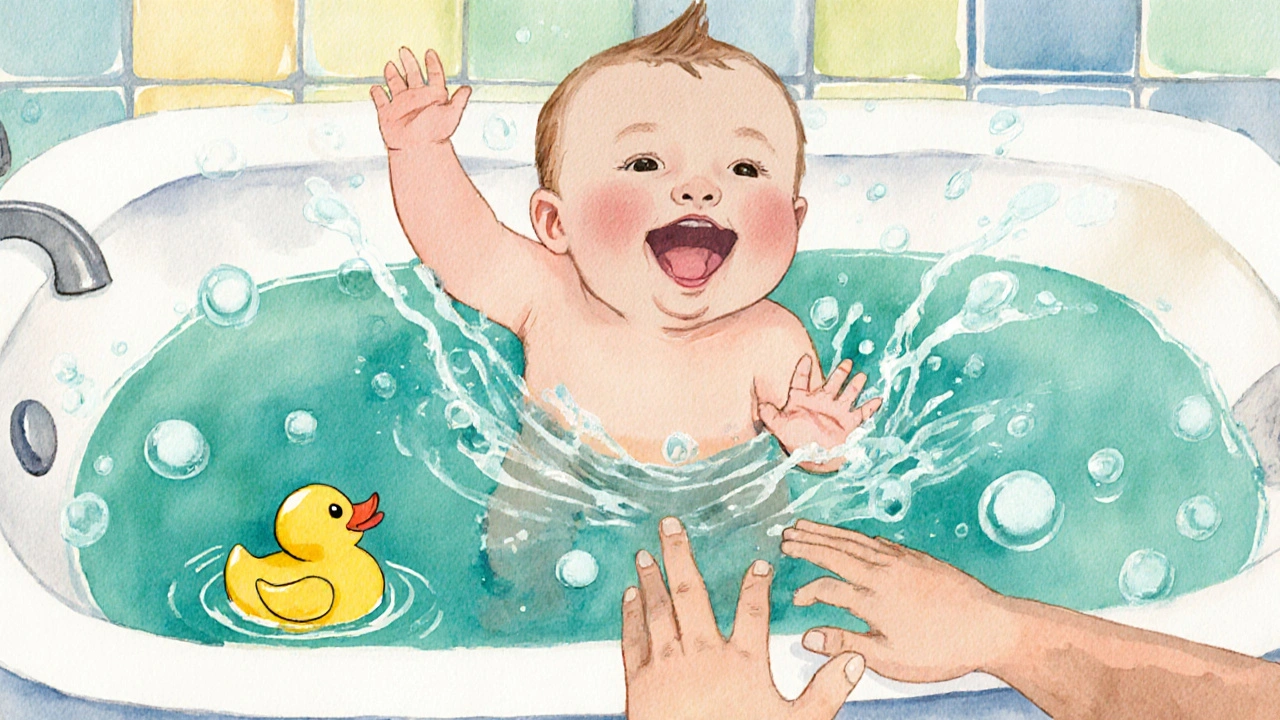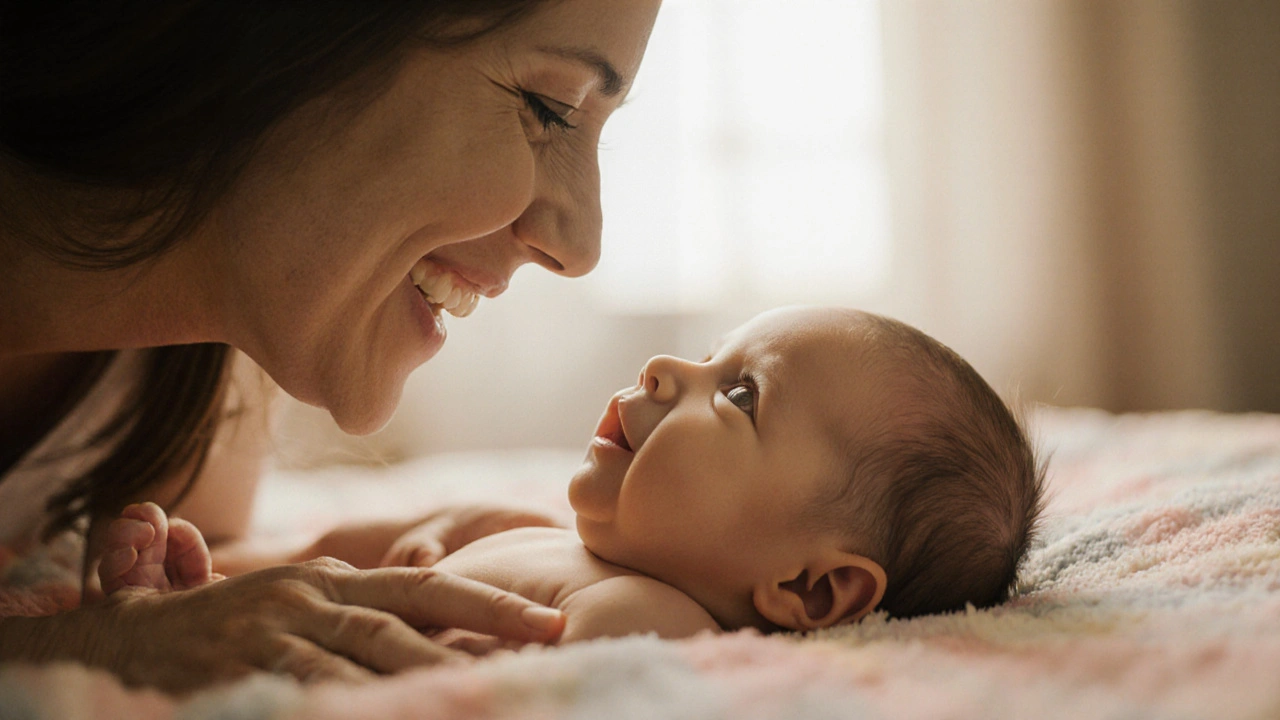Infant Language Milestone Tracker
Your Baby's Language Milestones
Current Stage
-
Typical Age Range
-
Progress Overview
- Know the key milestones from cooing to first words.
- Use responsive parenting to turn everyday moments into language lessons.
- Apply parentese-slow, sing‑song speech-to capture your baby’s attention.
- Introduce gestures early; they bridge the gap before words appear.
- Spot red flags and know when to call a speech‑language pathologist.
Parents often wonder why their baby suddenly starts babbling or how to get that first "mama" faster. The good news is that everyday interactions can act as a powerful language lab for your child. This guide walks you through what to expect in the first year, why certain tricks work, and how to spot signs that need extra help.
Understanding infant language development the process by which babies acquire the ability to understand and produce sounds, words, and gestures during their first years
From the moment newborns hear their mom’s voice, their brains start mapping sounds. By six months, most babies are experimenting with consonant‑vowel combos ("ba‑ba", "da‑da"). By twelve months, they usually say one or two words and can follow simple commands. These milestones aren't just cute; they reflect rapid neural wiring that sets the stage for later reading and school success.
Milestone Map: What to Expect From 0‑12Months
Below is a quick snapshot of typical language milestones. Keep in mind that each child is unique-some leap ahead, others take a little longer.
- Birth‑2months: Responds to voices, makes cooing sounds, shows attention to facial expressions.
- 3‑4months: Begins "babbling" (repeated consonant‑vowel sounds), watches mouth movements.
- 5‑6months: Experiments with varied pitch, starts using "canonical babble" like "ba‑ba" or "ga‑ga".
- 7‑9months: Uses gestures such as waving, pointing, and "bye‑bye"; understands "no" and simple "where" questions. Gestures hand motions that convey meaning before verbal language is fully formed
- 10‑12months: Says first word, follows two‑step commands, combines a word with a gesture.
Why Parentese a speech style with higher pitch, exaggerated intonation, and slower tempo used by adults when talking to infants Works
Research from the University of Cambridge shows that babies prefer the sing‑song quality of parentese. The exaggerated vowel sounds make it easier for their still‑developing auditory system to pick out speech patterns. Moreover, parentese signals to the infant that the speaker is emotionally engaged, which boosts attention.
Try this simple routine: when you change a diaper, narrate each step in a lilting voice-"Now we wipe-soft and gentle…"-and pause to let your baby absorb the rhythm.
Responsive Parenting: Turning Talk into Two‑Way Interaction
Responsive parenting means treating every babble as a conversation starter. When your baby coos, repeat the sound back and add a word: "Coo! That's a happy *coo*". This mirroring teaches cause‑and‑effect and shows the child that their sounds matter.
Here’s a quick checklist for responsive moments:
- Notice the baby’s vocalization or gesture.
- Pause for a beat-give them time to ‘respond’.
- Label what you see: "You’re reaching for the red ball!"
- Encourage a repeat: "Can you say ‘ball’?"
Consistent use of this pattern builds both vocabulary and confidence.
Comparing Parentese and Regular Speech
| Feature | Parentese | Regular Speech |
|---|---|---|
| Pitch | Higher, melodic | Natural, varied |
| Tempo | Slower, spaced | Normal conversational speed |
| Vowel clarity | Exaggerated, elongated | Standard pronunciation |
| Engagement | Strong eye contact, smiles | Often multitasking |
Both styles are fine, but studies indicate that parentese speeds up word comprehension by up to 30% in the first year.

When to Call a Speech‑Language Pathologist a professional who assesses and treats communication disorders in infants and children
Most delays are subtle. Watch for these signs:
- No babbling by 6months. \n
- Little or no eye contact when spoken to.
- Doesn't respond to own name by 12months.
- No single words by 16months.
If any of these appear, schedule an evaluation. Early intervention can add months of language exposure that directly improve later reading scores.
Building Vocabulary: Everyday Strategies
Vocabulary grows fastest when words are linked to real objects. Instead of saying "Look at that", say "Look at the red ball". The color and object name lock together in memory.
Rotate a "word of the day" during meals: "Today we’re learning ‘banana’." Let the baby touch, smell, and eventually try to say the word.
Practical Tips for Busy Parents
Life gets hectic, but language practice can fit into any routine.
- Bath time: Narrate each splash-"Splash splash, water is warm!"
- Car rides: Point out landmarks and name them.
- Playtime: Use toys that encourage turn‑taking (rolling a ball back and forth).
- Sleep routine: Sing a short lullaby and repeat key words.
These tiny minutes add up to hundreds of language exposures per week.
Common Myths Debunked
Myth 1: "Babies learn language on their own". In reality, they need a rich social environment; passive listening isn’t enough.
Myth 2: "Speaking multiple languages confuses infants". Research from the University of Toronto shows bilingual babies often achieve vocabularies comparable to monolingual peers by age three.
Myth 3: "If my baby isn’t talking, they’re lazy". Motivation comes from feeling understood, not from a desire to impress.
Next Steps and Troubleshooting
If you’ve tried these tips but still feel stuck, try a short audit:
- Record a 5‑minute play session.
- Count how many times you label an object vs. how many times you ask a question.
- Aim for a 2:1 ratio of labeling to questioning.
- Adjust your routine based on the tally and notice any changes over two weeks.
Should progress stall, consult a speech‑language pathologist for a personalized plan.
Frequently Asked Questions
When should I expect my baby’s first word?
Most infants say their first recognizable word between 10 and 14months, though some may speak a bit earlier or later. The key is consistent exposure, not a strict deadline.
Is it okay to use sign language with my newborn?
Absolutely. Early sign language provides a bridge before vocal cords are fully coordinated and can actually speed up spoken word acquisition.
How many words should a 12‑month‑old know?
A typical 12‑month‑old understands around 50words and may produce one or two words themselves. Understanding stretches far beyond what they can say.
Can background TV harm language development?
Yes. Studies from the American Academy of Pediatrics show that background TV reduces the amount of adult‑child talk, which is crucial for language growth.
My baby seems uninterested in talking. What should I do?
Increase eye‑to‑eye contact, reduce distractions, and use parentese. If lack of interest persists beyond 9months, consult a professional.
Putting these ideas into daily life turns ordinary moments into language‑building blocks. With patient, responsive interaction, your infant can master communication faster and stronger than you imagined.


Hannah Gorman
October 3, 2025 AT 19:30Wow, this article really tries to oversimplify the complex process of infant language development, and that's a problem. Parents often need nuanced guidance that goes beyond generic tips, yet the piece reduces everything to a handful of buzzwords. While the suggestion to use "parentese" is valid, the author fails to explain why the higher pitch actually engages a baby's auditory cortex. Moreover, the interactive milestone tracker sounds shiny but provides no scientific backing or references to peer‑reviewed studies. The lack of discussion about socioeconomic factors that influence language exposure is a glaring omission. A truly comprehensive guide would include strategies for bilingual households and for families where parents work irregular hours. It's also disappointing that the article doesn't address the role of responsive caregiving versus mere talkativeness. Research shows that contingent responses are far more effective than a one‑sided monologue. The text briefly mentions gestural communication, yet it glosses over how crucial joint attention is in the first nine months. A parent reading this might think they're covered, but they're actually missing critical pieces of the puzzle. The tone feels condescending, as if any parent who doesn't already know this is foolish. I would have liked to see a deeper dive into early phonemic awareness activities, not just babbling. In addition, there is no mention of screening tools for early detection of speech delays, which is essential. The author also neglects to advise on how to incorporate language learning into daily routines like feeding or diaper changes. Lastly, the article could benefit from linking to reputable resources such as the American Speech‑Language‑Hearing Association. In short, while the intentions are good, the execution is shallow and lacks the depth that serious parents deserve.
Tatiana Akimova
October 11, 2025 AT 23:17Listen up, folks! You can totally boost those babble skills right NOW-talk, sing, dance, and repeat those sounds EVERY SINGLE DAY! No more waiting, just ACTION!
Ted G
October 20, 2025 AT 03:05Did you ever notice how these "expert" articles are just pushing products disguised as advice? There's a hidden agenda to keep us buying apps and trackers. The whole industry is a massive data farm harvesting your baby's sounds. Wake up and question who really benefits from these so‑called "tips".
Dominique Jacobs
October 28, 2025 AT 06:52Alright, let's get real: if you want your kid to start chatting like a pro, you gotta be present and pumped up! Play with them, make silly noises, and don't hold back. Energy equals language growth-simple as that.
Claire Kondash
November 5, 2025 AT 10:40🤔 It's fascinating how energetic interaction intertwines with cognitive development. When caregivers engage in exaggerated intonation, they not only capture the infant's attention but also provide a scaffold for phonemic discrimination. This aligns with Vygotskian theory where social interaction is the catalyst for internalization of language. Moreover, the rhythmic patterns in "parentese" echo the natural prosody of infant-directed speech, fostering an environment where neural pathways for speech perception are reinforced. In practical terms, alternating between high‑pitch exclamations and gentle cooing can create a rich auditory landscape that challenges the baby's budding auditory system. Also, integrating everyday objects into the dialogue-like "here's the red ball, see?"-expands lexical exposure without feeling forced. Finally, remember that consistency matters; short, frequent sessions outweigh occasional long ones. 😊
Matt Tait
November 13, 2025 AT 14:27Honestly, this article reads like a checklist for clueless parents, missing the forest for the trees. It throws out buzzwords but forgets the science, making it more fluff than substance.